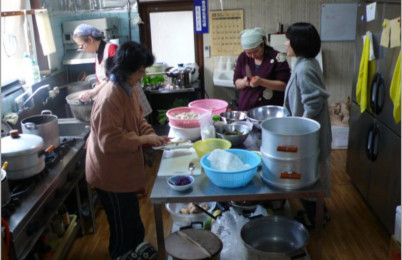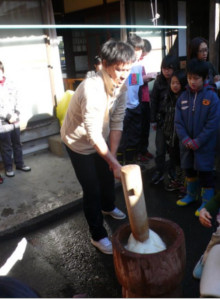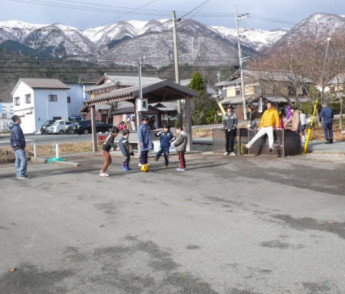As the end of year holidays arrived, a third respite break was organised in Takashima, a town close to Kyoto, for the children who live in the areas heavily contaminated by the Fukushima disaster.
Makiko Fujimoto is a mother, and it is she who organises these respite breaks simply because, for her, it is natural to do the most that you can to ensure that the children, wherever they are from, should be happy and free from suffering.
Because she is not normally involved in organising this type of event, it was not easy for her to begin with, but she was pleasantly surprised by the amount of good will expressed in so many different ways (gifts of money, gifts of food, accommodation offered at low prices, people offering to cook …)
So, following on from the first respite break in the Spring of 2012, and then a second in the Summer, there were now about forty children, accompanied by around a dozen parents, who were able to benefit from this third break which lasted nine days, and for a short time to get away from the heavily contaminated areas where they live.
For a number of days they are able to enjoy food that is uncontaminated, organically grown, varied and very well presented.
A variety of games and activities are also included in the programme and the overall atmosphere and the smiles and laughter show just how greatly appreciated it is.
Although the majority of the children are from the Fukushima region, others come from the neighbouring region of Ibaraki, as well as from Chiba (near Tokyo) which is further away, but nevertheless still contaminated.
Of course, these families are well used to the situation. They have carried out the medical examinations on their children: nodules on the thyroid, caesium-134 and caesium-137 in the urine …
All the parents obviously have a serious anxiety in common. Therefore, all of this group greatly appreciate the opportunity finally to talk about the things that concern them. This is particularly true for those parents who live close to Fukushima where it is very difficult, if not impossible to talk about the disaster and the problems of radioactivity.
In fact, there they not only face ‘denial’, the classic reaction in the case of major disasters, but also the fact that those who bring up the subject are seen as damaging the future of Fukushima and so they keep quiet. Moreover, given the discrimination suffered by the hibakusha (the survivors of the atomic bombs) and the fact that similar discrimination has already started against the inhabitants of Fukushima, there is no encouragement for people to speak out. So yes, the relief is real when you are finally able to speak freely, without fear of being rejected or frowned upon.
What is difficult for the parents is having no clear answers about the risks. Obfuscation and the playing-down of the risks are skilfully orchestrated by the nuclear lobby and the government, ably assisted by the ‘mainstream’ media. So, everyone is left with the same question: to leave or not to leave the contaminated area. And added to the uncertainties about the health risks there are then the specific circumstances of the individuals concerned: their jobs, their families, their attachment to a particular place… The decision is by no means an easy one. What should they do; what should they believe ?
Meeting these parents was extremely interesting and it was a real pleasure to spend time with these children who are so full of life. At the same time it was difficult to avoid thinking that, in a few years, some of them are bound to be suffering the effects of this terrible radiation. Three weeks before, at the Koriyama Conference, the members of the IAEA and the nuclear lobby had expressed their own certainty: “the accident at Fukushima has not killed anyone and we have not observed any health problems resulting from radioactive contamination, either among the workers or the general population,” according to Dr Weiss of UNSCEAR. And Maria Neira, representative of WHO, continues to quote the long list of WHO’s supposed actions concerning this disaster. So, when I go back again to take part in the Vigil outside WHO Headquarters, I think that I would like more than ever to carry the sign which says “Cover Up and non-assistance = CRIME”.
Christophe Elain – Kyoto – 8th January 2012




